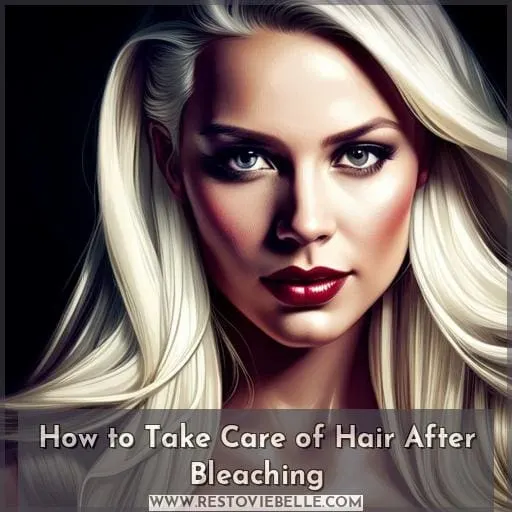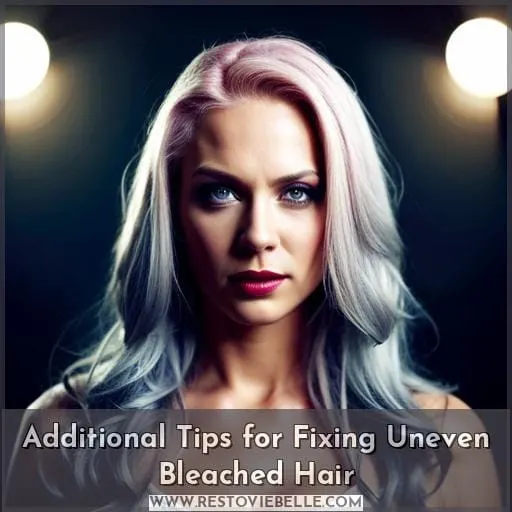This site is supported by our readers. We may earn a commission, at no cost to you, if you purchase through links.
 Unlock the secrets to reclaiming your hair confidence with our comprehensive guide on fixing uneven bleached hair at home.
Unlock the secrets to reclaiming your hair confidence with our comprehensive guide on fixing uneven bleached hair at home.
You decided to embrace a bold change, bleached your hair, and ended up with a less-than-ideal outcome.
Discover two approaches to remedy the situation: a swift solution by dyeing your hair with a darker shade, or a gradual path through re-bleaching after 3-4 weeks.
Your journey to hair mastery begins with understanding what went wrong during the bleaching process, from dark hair base challenges to mixing mishaps and incorrect application techniques.
Armed with this knowledge, you’ll be ready to transform your uneven bleached hair into a stunning mane you’ll be proud of.
Table Of Contents
Key Takeaways
- Two options for fixing uneven bleached hair: a fast fix with a darker color or a slow fix with re-bleaching after 3-4 weeks.
- Address challenges with dark hair bases and emphasize the importance of balancing toning.
- Ensure precision in bleach mixing and proper sectioning during application for even results.
- Establish a comprehensive aftercare routine, including hydration, UV protection, and the use of quality products, which is essential for maintaining hair health.
How to Fix Uneven Bleached Hair
To fix unevenly bleached hair, you have two main options: the fast way and the slow way. The fast way involves dyeing your hair with a darker color to even it out, but make sure to wait a day if your hair is very dry before proceeding.
Alternatively, the slow way entails re-bleaching your hair after 3-4 weeks using Truzone Peroxide, allowing the necessary wait time to avoid further damage.
Fast Way – Dye Hair With a Darker Color
If you’re seeking a swift solution to remedy unevenly bleached hair, why not give your locks a fresh, darker hue to even things out? Dyeing your hair with a deeper color can effectively conceal those uneven patches and create a more consistent look.
Make sure you select a shade that complements your skin tone and meticulously follow the dyeing process. Remember to follow up with moisturizing techniques and toning tips to maintain the vibrancy of your newly dyed hair.
Don’t forget to shield it from UV rays with appropriate products and uphold a robust aftercare routine.
Slow Way – Re-bleach Hair After 3-4 Weeks
Ready to embark on the slow but effective journey to achieve a more even tone in your tresses? The slow way to fix unevenly bleached hair requires patience and careful steps:
-
Choosing the Right Peroxide: Opt for a product like Truzone Peroxide to re-bleach your hair. This choice is crucial for achieving a more even and controlled result.
-
Re-Bleaching Safety: Remember to prioritize safety by waiting at least 3-4 weeks between bleaching sessions. This time allows your hair to recover and minimizes damage.
-
Hair Strengthening: During this waiting period, consider using Jamaican Black castor oil to strengthen your hair roots, ensuring they remain healthy and strong.
The slow way may take time, but it’s a safer approach to achieving beautifully even bleached hair.
What Went Wrong With Your Bleaching Process?
If you’re wondering what went wrong with your bleaching process, several common culprits might have caused your unevenly bleached hair. Your dark hair base can turn orange or red if not bleached properly, emphasizing the need for precision in the process.
Mixing the bleach incorrectly using a brush and container, as well as applying it incorrectly without sectioning your hair, are key factors that could result in uneven tones.
Dark Hair Base Color
Experiencing a dark hair base color during the bleaching process can result in an undesirable orange or red tone in your locks. This bleach accident often occurs due to improper bleaching techniques or inadequate product application.
To correct the brassiness and balance shades, consider direct reapplication of bleach. However, exercise caution and consult a professional as bleach failures can be tricky to rectify. It’s essential to get it right the second time around to achieve your desired look.
Mixing the Product Incorrectly
To achieve the perfect blonde, make sure that when mixing the product, you blend the bleach and developer thoroughly using a brush and a container for even consistency. Common mistakes in mixing bleach can lead to uneven hair color. Avoiding blunders here is crucial.
Incorrect product mixing can result in a wrong application, leaving your hair with patchy, uneven tones. To correct these errors, take your time and ensure the bleach mixture is homogeneous. If necessary, you can partially re-bleach your hair to achieve a more uniform shade.
Wrong Application Techniques
Ensure that when applying bleach, properly section your hair for an even and balanced outcome. Hair coloring techniques demand meticulousness; sectioning aids in even application. Spot-bleach missed areas to ensure uniformity. Improper application methods lead to uneven bleached hair.
Mindful application technique, considering hair porosity and using the right bleach mixture, prevents damage and achieves a smoother, more consistent result.
How to Take Care of Hair After Bleaching
To care for your hair after bleaching and address any unevenness, it’s essential to utilize hydrating products such as Fudge violet toning shampoo and conditioner. Additionally, apply a hydrating mask weekly to restore moisture and health to your hair.
Remember to shield your newly bleached locks from UV rays with specialized products designed to protect your hair from sun damage.
Use Hydrating Products
Enhance your post-bleach hair care routine by indulging in hydrating products that can help you maintain the lusciousness of your newly lightened locks.
-
Hydrating Products: Invest in hydrating shampoos and conditioners, such as Fudge violet toning products, to keep your hair moisturized and vibrant.
-
Hydrating Mask: Apply a weekly hydrating mask to deeply nourish your hair, combating dryness caused by bleaching.
-
Moroccanoil Treatment Oil: Use Moroccanoil Treatment oil on a clean scalp to add shine and protect your hair from further damage.
-
UV Protection: Shield your hair from the sun’s harmful UV rays with specialized UV protection products.
With these hydrating products, your bleached hair will not only look stunning but also stay healthy.
Apply a Hydrating Mask
Pamper your locks with a weekly hydrating mask for that much-needed moisture boost. Applying a hydrating mask is a crucial step in fixing uneven hair color after bleaching. These DIY hair masks offer a host of benefits, including deep hydration, color correction, and improved hair health.
Hydrating Mask Benefits
- Restores moisture
- Repairs damaged hair
- Enhances color vibrancy
- Prevents further damage
Mask Application Tips
- Apply to damp hair
- Comb through evenly
- Leave on for 20-30 mins
- Rinse with cool water
Weekly Mask Routine
- Use once a week
- Consistency is key
- Prioritize hydration
- Adjust to your hair
Hydration Techniques
- Focus on ends
- Avoid roots
- Use steam or heat
- Cover with a cap
Maintain this weekly ritual to take care of your hair after bleach and gradually achieve a beautifully even and healthy look.
Protect Hair From UV Rays
Guard your delicate strands as if they were precious silk by shielding them from the relentless sun, for the sun’s fierce embrace can rob your locks of their luster and resilience. UV protection is paramount in your post-bleach hair care routine. Invest in UV-blocking products or specialized hair sunscreen.
Apply them generously before sun exposure to prevent sun damage, particularly if you have dark hair color.
Tips for Post-Bleach Hair Care
To effectively address the aftermath of unevenly bleached hair, it’s vital to use quality aftercare products that will nurture your hair back to health. Furthermore, maintaining a consistent hair care routine will be the key to sustaining the vibrancy and strength of your newly treated locks.
Use Quality Aftercare Products
To ensure your newly lightened locks maintain their luster and vibrancy, select premium aftercare products tailored to your specific needs. When it comes to post-bleach hair care, making the right product choices can make a world of difference.
-
Choosing the Right Products: Opt for quality items like Fudge violet toning shampoo & conditioner to keep your blonde looking fresh and free of unwanted hues.
-
Hair Hydration: Ensure your hair stays hydrated with regular use of nourishing masks and conditioners to combat dryness and maintain softness.
-
UV Protection: Protect your hair from the harmful effects of UV rays with specialized products designed to shield your locks from the sun’s harsh rays.
These steps are essential in preserving your stunning post-bleach results and ensuring your hair looks its best.
Maintain a Regular Hair Care Routine
Nourish your locks with deep conditioning treatments that are like a refreshing drink for your strands, helping to restore their vitality and shine.
| Step | Treatment | Frequency |
|---|---|---|
| 1. | Hair Masks | Weekly |
| 2. | Scalp Health | Daily |
| 3. | Toning Techniques | As needed |
| 4. | UV Protection | Whenever outdoors |
| 5. | Nutrition Tips | Daily |
These steps ensure your post-bleached hair stays healthy and vibrant, ready for your next adventure in home bleaching.
Additional Tips for Fixing Uneven Bleached Hair
Transitioning from post-bleach care to the final stretch of perfecting your unevenly bleached hair, let’s delve into additional tips that can help you achieve hair color mastery and maintain optimal hair health.
Here are four crucial steps to elevate your hair game:
-
Balancing Toning: When dealing with uneven shades, use toning shampoos that contrast with the unwanted tones. Blue for orange, red for green, and purple for yellow. This helps neutralize and balance out the colors effectively.
-
Spot Bleaching: For those missed sections or areas that need a lighter touch, spot bleaching is your savior. Apply a smaller amount of bleach directly to the problem spots, ensuring even coverage.
-
Diet and Hair: Don’t underestimate the power of a nutritious diet. Enhance hair health with a diet rich in multivitamins, minerals, and omega-3 fatty acids. These essential nutrients contribute to the strength and vitality of your locks.
-
Color Correction: Sometimes, it’s necessary to revisit your hair with bleach for a lighter shade. Follow the same techniques you used before, ensuring even application and allowing adequate time for the process.
With these additional tips, you’re well on your way to achieving that evenly bleached, beautiful blonde look while maintaining the health of your hair.
Conclusion
Mending unevenly bleached hair resembles orchestrating a symphony. Whether you opt for the quicker route of dyeing your hair with a darker color or choose the more patient approach of re-bleaching after a few weeks, precision is the key to success.
Take into account the nuances: the hue of your dark base color, the meticulous mixing of bleach, and your application technique. Nourish your newly blonde locks with hydrating products and diligent care. In this journey of hair transformation, remember that fixing unevenly bleached hair is an art, and you’re the artist.









